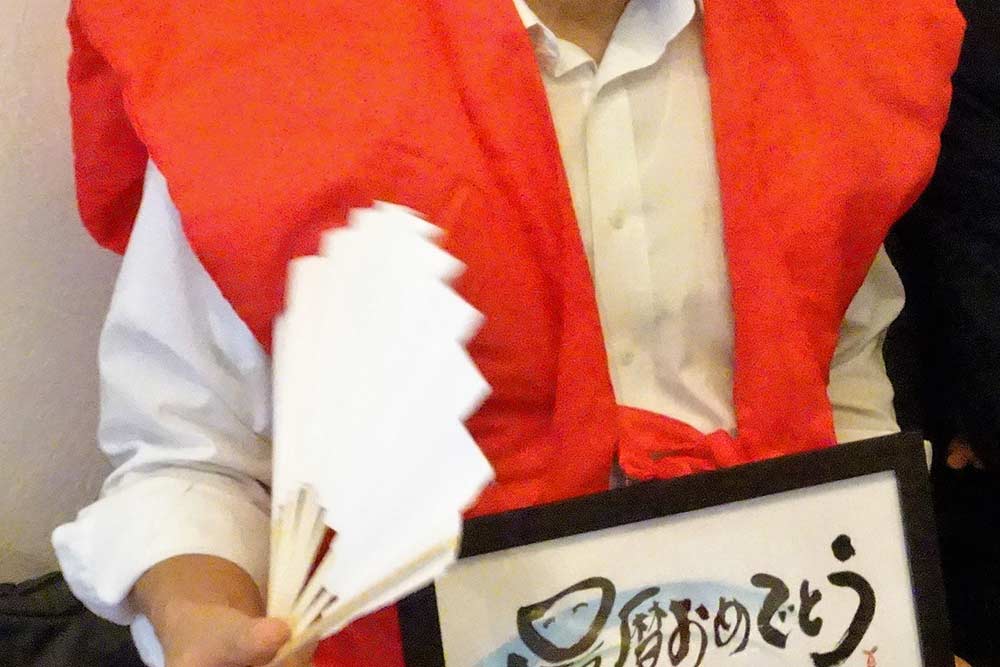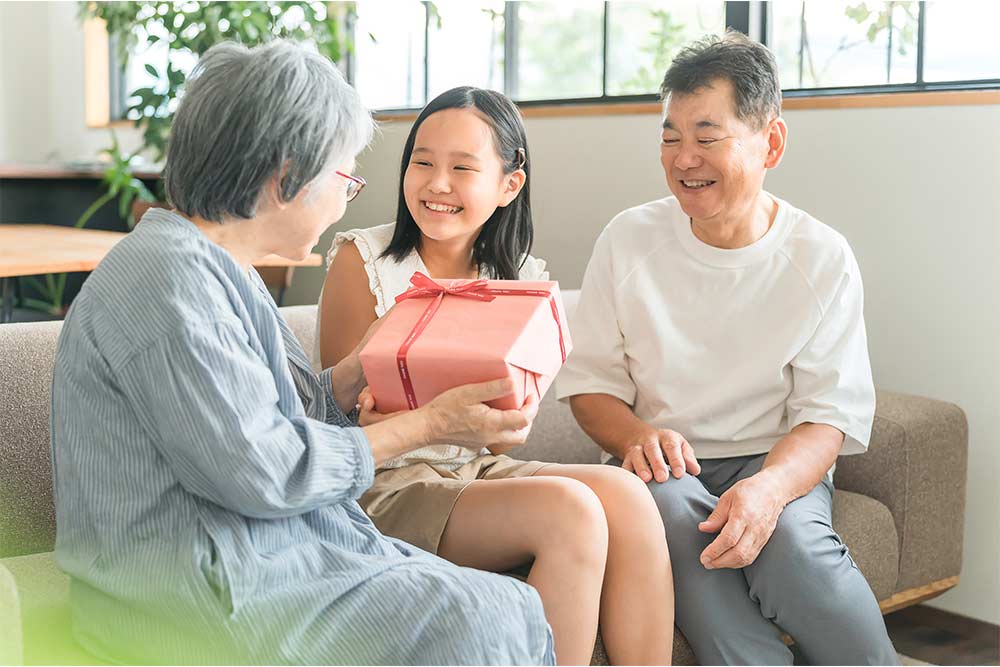In this article, we would like to talk about the culture of “Celebrating longevity” in Japan. The custom of celebrating longevity as a matter of congratulation seems to be one of the common cultural practices found in many foreign countries as well. Incidentally, Japan also has a holiday called “Respect for the Aged Day” that is designated by law as a day of respect for the elderly. Of course, the age at which longevity is defined will depend on the cultural background, including religion and other factors. For example, in the Western world, it seems that people roughly start celebrating at about age 50~60. After that, they celebrate every 10 years. In the Asian region, the “60th birthday (the least common multiple of 10 and 12)” is often considered a turning point based on the “十干十二支” calendar system, as in China and Korea. We heard that in Thailand, where most people are Buddhists, they celebrate their age every 12 years after the age of 60. In Japan, too, the celebration of longevity begins with the “60th birthday (it is called “Kanreki”)” ceremony. And they will continue to celebrate every 10 years after age 60. Furthermore, the so-called “Zorome” age, in which the number in the tens place matches the number in the ones place, is also celebrated. Umm… For Japanese, there are quite a few opportunities to celebrate longevity, right? Perhaps it is because our culture loves to “Practice superstition” with words and numbers. Our predecessors would have thought that the more happy occasions, the better. Well… Each of the ages celebrated has its own celebratory color (theme color), but there are many theories as to the origin of these colors, and it is not very clear… OK, below are some of them.
※”十干十二支” is “Sexagenary cycle (the Oriental cycles of fortunes)” calendar system in China.
Age 60.

This is called the “還暦(kanreki)”. It is celebrated when “十干十二支” calendar make a full revolution and return to the zodiac sign of one’s birth. It’s theme color is red. As mentioned above, “十干十二支” calendar make a complete cycle, and red is used as the celebratory color because it is analogous to “returning to a baby (in Japanese, “baby” is called “akago(red babe)”). The color red has a meaning of “ward off evil”, and was used for baby clothes. Following this custom, people who have reached the age of 60 are usually made to wear red costumes (hoods and chanchankos) at the party. In Japan, age 60 was also considered the general retirement age, making it one of the most widely known celebrations of longevity.
Age 70.
It is called the “古稀(koki)”. It is said to have originated from a line in a poem “曲江(Kyokko)” by 杜甫(Du Fu, a Chinese poet of the Tang Dynasty), “人生七十古来稀也”. The meaning of this line is that “people who live for seventy years have been rare for a long time”. The celebration color is considered purple or navy blue.
Age 77.
It is called the “喜寿(kijyu)”. It is said that the kanji character for “喜” was derived from the fact that it looked like “七十七” when written in “草書体(a running hand)”. The number “7” is considered auspicious, as is also known from the “七福神 (seven gods of good fortune)” and the “七草 (Japanese seven herbs)”. The fact that the number “7” is the age of two such numbers in a row is also a major reason why 77 years old was considered an age to be celebrated. Its celebration color is purple. Incidentally, purple has been considered one of the most noble colors in Japan since ancient times.
Age 80.
The age of 80 is called “傘寿(sanjyu)”. The kanji character for “傘” can be abbreviated to “仐”. “仐”→”八十”, right? The kanji character for “八” is said to be “末広がり (suehirogari)” because of its downward spreading shape, which is also considered an auspicious number. The celebrating color is yellow (or even golden brown).
Age 88.
It is called the “米寿(beijyu)”. It is said that the origin of this name comes from the kanji character for “米”, which is broken down to “八十八”. Like the above-mentioned “喜寿(kijyu)”, it is an age with two auspicious numbers in a row. There is no other choice but to celebrate, right? The festive color is golden brown. To be honest, “I” am not really familiar with the golden-brown ones… For instance, pyrite…?
Age 90.
It is called the “卒寿(sotsujyu)”. The kanji character for “卒” can be abbreviated to “卆”, it seems to be the origin of the name. “卆”→”九” & “十”, OK? The celebrating color is purple, again the same as that of the Seventies. Why…?
Age 99.
The 99th birthday is called “白寿(hakujyu)”. 99 is 100 minus 1, right? The kanji character for 100 is written as “百”. And 1 is written as “一”. If you remove the “一” from the kanji character “百”… “白”. This kanji character means “white”. Who came up with this idea…? Considering the origin of each age after “喜寿(kijyu)”, it seems to be a concept that originated in Japan. Of course, the celebration color is white.
Age 100.
It is called “紀寿(kijyu)”, because kanji character “紀” means “one hundred years” or “one century”. It is also called “百寿(hyakujyu / momojyu)”. The celebrating color is usually white or pink. It seems that when it comes to longevity of 100 years old, there are many celebrations from countries, municipalities, etc., even overseas? In Japan, a congratulatory letter from the Prime Minister and a silver cup are presented by the government.
Age 111.
The age of 111 is called “皇寿(koujyu)”. The kanji character for “皇” can be broken down into the parts “白”, “一”, “十”, “一”, right? As mentioned above, “白” = 99. “十” this kanji character means 10. 99 + 1 + 10 + 1 = 111. It is the age of three “一” in a row, and “一” is also a lucky number. Wow, we must celebrate. Incidentally, there is no particular color to celebrate. Celebration colors seem to disappear especially after 100 years of age…
Age 120.
The second “60th birthday” is called the “大還暦(daikanreki)”.
In addition to the above, there are also “緑寿(rokujyu)” at age 66, “半寿(hanjyu)” at 81 age, “珍寿(chinjyu)” at 95 age, and “茶寿(chajyu)” at age 108… Please reseach them out if you are interested.
Japan is well known among developed countries for the long average life expectancy of its citizens. This has become more pronounced since the period of rapid economic growth, when the living environment, including food, clothing, and housing, has greatly improved. It could be said that the development of medical technology is also a very significant factor. On the other hand, as is the case in other countries, the “aging” of the population is a major problem, as both the number of elderly people and their proportion in the population are rising. At the same time, a very large number of countries have experienced an accelerated decline in fertility rates, right? Well, even in Japan, these are quite serious conditions… We cannot help but wonder if there is some way to create a society in which people around the world can live long and prosperous lives in peace and tranquility.




